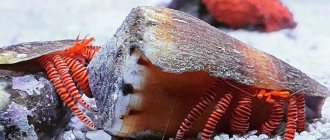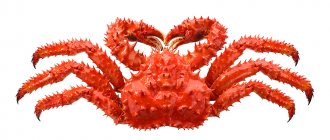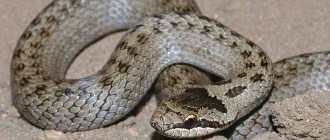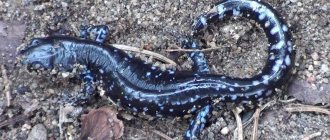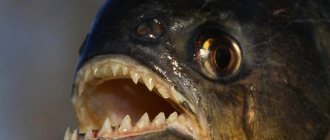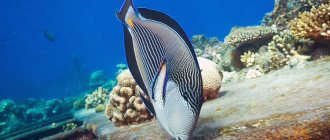Marine crustaceans
Simplicity of content:
Latin name: Pagurus Bernhardus
Lifespan: up to 11 years
Maximum size: 15 cm.
Average cost: from 500 rub.
The hermit crab belongs to the class of crustaceans. There are many species, each of which deserves attention, but not all hermits are suitable for keeping in an aquarium. And those that are suitable require some knowledge from the owner. Which ones? Let's find out in the article.
Origin of the species and description
Photo: Hermit crab
The hermit crab is a species of decapod sea crayfish, an infoorder of incomplete tails that inhabit the shallow waters of coastal zones of the subtropics and tropics. He is unpretentious in food, omnivorous. His main feature is that he always wears a shell. The shell that serves as a home for the hermit crab often comes from mollusks.
The entire back part of the crayfish’s body easily fits in the shell, while the front remains outside. A kind of shell house serves as excellent protection for the arthropod, so it never leaves it, but changes it as needed when its size increases.
Video: Hermit crab
Today there are a large number of different types of hermit crabs that inhabit all the seas of the planet. The largest species reaches 15 cm in size. The hermit crab is difficult to see, only in rare cases when it leaves its shelter. The body of an arthropod transforms over time to suit the characteristics of the shell in which it lives.
For additional protection, cancer has at its disposal many devices, incl. a layer of chitin abundantly covering the front part of the body. The shell serves to protect the animal from enemies. The hermit crab removes it during the molting period. Over time, a new layer of chitin grows again on its body. Old shells can serve as food for cancer.
Proper water is the key to health
The only problem in keeping crayfish optimally is the selection of water. The fact is that ordinary chlorinated tap water burns the gills and leads to the painful death of pets
It is important to use purified water for both drinking and hydration. Purchase several bottles of clean water from a pet store.
Don't forget about the aqua conditioner. The usual biological film is not suitable for this purpose; it can only be used for bathing crayfish and for keeping fish. It is necessary to find an air conditioner that will remove chlorine from the water and neutralize metals.
Crayfish use two types of water: fresh and salt. If everything is clear with fresh water, then salted water must be prepared at the rate of 10 tablespoons of aquarium salt per 1 batch of water. Wait 12 hours until the salts are completely dissolved and let the crayfish enjoy. The humidity of the aquarium should be between 79-89 percent.
Appearance and features
Photo: What does a hermit crab look like?
The sizes of hermit crabs vary and depend on its species. From the smallest 2 cm to the largest 15 cm. The appearance of the hermit crab is very unusual.
The body is divided into the following parts:
- soft body;
- head combined with chest;
- legs;
- mustache;
- claws
The claws are located next to the head. The right claw is larger than the left one. Cancer uses it as a gate to enter the home. The hermit uses his left claw to obtain food. The legs, which are used by arthropods to move, are located next to the claws. Other small limbs are not used by cancer.
The front part of the body is covered with chitin, which forms a fixed shell. The back soft part of the hermit crab's body is not covered with chitin, so it hides it in the shell. Small hind limbs securely fix the shell, so the arthropod never loses it.
Hermit crabs use shells of various mollusks as their houses:
- Rapanov;
- gibull;
- puss;
- cerithium.
For convenience, the arthropod chooses a shell of a size that exceeds its body. The large claw of the hermit crab reliably blocks the entrance to the shelter. Hermit crabs actively increase in size throughout their lives, so they are forced to constantly expand their living space. To do this, they change their shell to larger sizes as necessary, using only free ones. If a hermit crab for some reason does not find a suitable shell, it can move in with another relative.
Interesting fact: A hermit crab can use not only a mollusk shell as a house, but other objects of a suitable shape: a glass, a lid, etc.
Comments
Comment from Solaire
I located one underwater in Boralus Harbor in Boralus, south of Tradewinds Market. However, when trying to enter a battle, I kept getting the “Pet battle area is obstructed” error. I noticed my character was continuing to tread water and wouldn't walk on the sea floor — I believe this is the cause for the error. I submitted that info as a bug, just in case.
Just got SS breed (common).
Comment by fr0z3night
You may need the Desert Flute or something similar to catch these underwater Battle Pets, not sure if its only usable in Vuldun or if there is an equivalent item for other zones, found this on the other Hermit Crab page.
Comment by deathbybunnies
In Boralus, to avoid the « pet battle area is obstructed
» error, I simply stood on the dock (to the far left of Will Melborne, ferry master, behind a boat) at
75.18 23.60
and waited for a hermit crab to walk near enough underwater to turn my cursor green and clicked.
(You can click from farther away than you think.) I battled a single hermit crab on the dock and there were no additional pets. My Darkmoon Zepplin's target dummy absorbed it's whirlpool nicely. I used the same strategy on the neighboring shack crab.There are also a lot of hermit crabs on land all over the small islands in north and east Stormsong Valley.
Comment by Icytroll
This battle pet can be found on almost any beach area in Zandalar and Kul tiras.On a side note, I spent a good half hour walking up and down the western beach of Vol'dun, and I've not seen a single rare Hermit Crab, only Uncommon quality and below.
Comment by Mopatop
I found alot of these on the island north of Stormsong Valley at 67, 12. After 2 hours of server hopping and killing all non-rares that i came across, I just gave up and used an upgrade stone. Feels impossible to find a rare version. Must have tried around 300 encounters or more since BFA launch, I don't know if i'm extremely unlucky or if this is a bug.
Comment by dotrich
I'm convinced that rare Hermit Crab do not exist in the wild. I have battled dozens upon dozens and have not found a single rare!Edit:In addition I have found that if two Hermit Crab dive at the same time, the first will be able to hit the other.
Comment by TheMostUnfunny
For clarification by a gm, the reason we get “Pet Battle Obstructed” isn’t a bug, rather the environment around the pet battle is unsuitable for the actual battle. IE, fighting something underwater, fighting something when flying/mounted, etc. But there are plenty that walk on land in Vol'dun to the west around Shatterstone Harbor/Terrace of Devoted. (Ps, went through 49 pet battles and haven't seen a single Rare quality Hermit crab :/)
Comment by djkillj0y
Glad to see i'm not the only one who is scouring the beaches in Vol'Dun and can't find a rare quality crab. I know i've seen S/S and P/P breeds of this pet as well, don't know if I've actually seen B/B. Anyone see any other breeds? I'm pretty sure this wowhead entry is missing a huge chunk of data.
Comment from Zillion2010
These pets seem to be over the usual limit for pet stats.At level 25 it will have 1400 hp, 284 attack, and 349 speed. Compared to say the Barrier Hermit which has 1400 hp and 289 attack and speed; total 578 stats + health, or an S/S Rabbit which has 1400 hp, 227 attack, and 357 speed; total 584 stats + health. The Hermit Crab has 633 stats + health.In fact, the only pet that has more raw stats (that I have, but I have most) is the Sapphire Cub which has 650 stats, but only has 1075 health because of it. The next up from that is pets with 1197 health to have 626 stat points.
Comment by Lyssandria
I finally
found a rare S/S Hermit Crab after hours of farming all over for these elusive guys. I found mine on the shores of the island that's north-west-ish from the Shrine of the Storm in Stormsong Valley. Most of them are on land (so there's no “pet battle area is obstructed”) and there are no enemies to contend with. I found that by the time I'd done one circuit of the island the crabs were re-spawning again, so not really any downtime either. Most were poor or uncommon quality, but I did see a green one as well as the rare. Hope this helps someone with their grind!Happy hunting!
Where does the hermit crab live?
Photo: Black Sea hermit crab
Hermit crabs inhabit exclusively reservoirs with clean water. Therefore, a large population of these arthropods indicates a clean ecological situation in this place. Recently, the catastrophic situation with sea pollution has led to a sharp decrease in the number of hermit crabs.
Hermit crabs prefer to live in shallow water. But there are certain species that descend to a depth of 80 m under water. Today, hermit crabs can be found on the shores of Australia, in the Baltic Sea, the North Sea, on the coast of Europe, in the Mediterranean Sea, on the coast of the Caribbean islands, Crudasan Islands.
However, not all hermit crabs prefer to live in water. There are land hermit crabs that live on the islands of the Indian Ocean. They live on land almost their entire life. With their constant movement, land hermit crabs dot the entire coastal zone, and the trail left by arthropods resembles that of a caterpillar tractor.
For land arthropods, the issue of expanding their living space is very acute, since there is no particular choice of shells on land. Therefore, the hermit crab has to try hard to find the necessary housing. Land hermit crabs are found both on the sandy shores of the islands and in the forests of the coastal zone. However, most arthropods choose sea and fresh water to live.
Now you know where the hermit crab is found. Let's see what he eats.
What are sea anemones?
Sea anemones are animals belonging to the class of coral polyps. They are also called sea anemones; they thrive in the seas and oceans: they have mastered a variety of depths, and are also found at different latitudes - both in cold polar waters and warm tropical ones. Sea anemones, with their amazingly bright color and shape, resemble strange flowers. However, they are gentle and harmless only at first glance. Sea anemone is a serious predator, since its poison is very close in strength to that of curare, and it is so strong that a drop is enough to kill a leopard. The tentacles of the sea anemone are equipped with stinging cells, and aconcia, resembling long threads with poisonous “arrows,” are thrown out of the mouth and pores of these animals. The vast majority of marine inhabitants avoid encounters with sea anemones, but there are exceptions. Many representatives of one of the families of marine invertebrate animals have adapted to live next to sea anemones on mutually beneficial terms - these are hermit crabs.
What does a hermit crab eat?
Photo: Hermit crab in nature
In order to fully get to know the hermit crab, it is worth knowing its diet. In this way, the hermit crab is very similar to its relatives - crustaceans, which means it is also omnivorous and not picky. He does not disdain plant and animal food. His favorite delicacies are: algae, worms, fish eggs, shellfish, and fish.
It happens that a hermit crab can snack on carrion or food debris left over from nearby sea anemones. If, for some reason, the crayfish has to go to land, then they feed on coconuts, fruits or small insects.
When a hermit crab molts, it sheds its shell and eats it, since it consists of organic remains. This arthropod picks up any organic food. The region where the hermit crab lives greatly influences its diet. But in most cases, these are still algae, fish, worms, small crustaceans or echinoderms.
They mainly obtain food in the tidal coastal strip, or on some rocky surfaces. As for individuals living in aquariums, they can eat special food, or whatever is left on the dinner table, porridge, pieces of chicken, or any grocery products. To add some vitamins to his diet, you can feed him pieces of fruit.
Keeping in an aquarium
The common hermit crab is unpretentious and thrives in artificial reservoirs. The aquarium must have toys that will be comfortable for your pet to climb on. Pebbles, shells, plant branches and artificial algae are suitable.
The size of the aquarium is selected depending on the expected number of inhabitants. For 2-4 individuals, 40-60 liters will be enough. The optimal water temperature is +24...+30 ºC, acidity - 8 pH, salinity - 35-37. It is good to use moss as additional food.
Fine sand is poured onto the bottom of the tank to avoid injury to the animal. The thickness of the layer should exceed the height of the largest crayfish in the aquarium by about 5 times.
This will allow the small arthropod to easily burrow and hide, and create caves during molting. The aquarium should have empty shells of different sizes so that the hermit crab can choose a new home.
The lifespan of an individual in an artificial ecosystem with proper care is about 30 years.
Features of character and lifestyle
Photo: Hermit crab from the Black Sea
The hermit crab is distinguished by its courage and endurance. Since he is hunted by a large number of enemies, he has to defend himself all his life. That is why he drags the shell everywhere. Along with this, he tries in every possible way to “establish” contacts with his brothers, even to negotiate. To establish their comfortable living, hermit crabs can exchange shells.
The moment an arthropod changes its home, it becomes most vulnerable. For additional shelter from predators, the hermit crab hides under rocks and in gorges. But this shelter becomes extremely unsafe for him during low tides.
For some lonely hermit crabs, symbiosis with poisonous sea anemones is suitable. Such coexistence is mutually beneficial for both parties, since it helps to obtain food, and does not at all limit their independence. A striking example of such a symbiosis is the union of an arthropod and a sea anemone. Anemone settles on the shell of a hermit crab and uses it as a carrier.
Neighbors feed on each other's leftover food. Together they can easily fend off predators. I call such mutually beneficial symbiosis mutualism, and they do no harm to each other at all. The union breaks up only when the hermit crab is forced to change its shell due to an increase in size.
An adult hermit crab reaches quite a large size and becomes strong. The arthropod lives exclusively in clean water. The hermit crab is active in search of food at any time of the day. “Preparing” food and eating it takes him relatively little time.
Interesting fact: The hermit crab independently scouts and eats fish to the bone in just a couple of hours.
Habits
Mating games and the fight for a female in hermit crabs begin in the spring and can last all summer. The hermit mother carries the eggs inside her house. After maturation, young, larval-like crustaceans immediately float into the water column. Several more “rebirths” and molting will take place before the soft crustacean sinks to the bottom in search of its first home. It is necessary to find an apartment that is sized, because in a large space it will not be possible to spread out small legs. The period of adolescence for a hermit is the most difficult and unpredictable; at this time, a larger number of larvae will be eaten.
Every season the crustacean must grow, for this it is necessary to find a larger snail. The increase in size begins only after finding a new living space.
Hermit crabs are the beach cleaners of Anapa. They prefer dead underwater animals as food, thereby quickly cleaning the bottom. Thanks to hermit crabs, divers see a beautiful plain underwater.
Social structure and reproduction
Photo: Hermit crab
Hermit crabs, which live in water, prefer to stay with their fellows.
Living together with hermit crabs has the following advantages:
- the hermit crab does not need to waste energy searching for the right shell, since its fellow crabs “acquire” an expanded living space and leave their shell;
- It is much easier and simpler for hermit crabs to search for food together. As soon as one hermit crab finds food, he immediately informs the rest of his community about it;
- It is much safer to coexist in a group, since this way it is much easier to defend against enemies.
If at least three hermit crabs gather in one place, their other relatives crawl into the same place. A dozen arthropods form a “heap” in which everyone climbs on top of each other and tries in every possible way to throw each other off. In such a brawl, crayfish lose their shells. But at the same time, especially nimble individuals can acquire new and improved housing.
Land hermit crabs do not like to intersect with relatives precisely because of such gatherings. Left without shelter on land, it is difficult for them to find a new shell. The reproduction process of hermit crabs is based on competition between males and females. Reproduction of arthropods occurs all year round. During the process of their mating, eggs are produced, which they carry on their abdomen.
Interesting fact: A female hermit crab bears up to 15 thousand individuals.
After a week, larvae emerge from the eggs and are able to live independently in water. After four stages of molting, the larvae become small crustaceans that settle to the bottom. The primary task of young people is to find shelter in the form of a shell, so as not to become food for predators. In fact, only a few survive; even at the maturation stage, many larvae die. On average, a hermit crab lives 10 years.
Symptoms
At an early stage, the disease is asymptomatic. After the transformation of atypical cells into malignant ones and their spread to nearby tissues, specific symptoms may appear:
- bloody discharge from the genital tract outside of menstruation (after sexual intercourse or a gynecological examination);
- heavy menstruation that lasts longer than usual;
- postmenopausal vaginal bleeding;
- heavy or unusual vaginal discharge;
- discomfort and pain during intimacy;
- pain in the lower back, abdomen, pelvic area;
- frequent urination, pain when urinating, constipation (pelvic organ compression syndrome);
- unexplained weight loss.
Natural enemies of hermit crabs
Photo: What does a hermit crab look like?
The soft, nutritious body of the hermit crab is of interest to many marine inhabitants. An unprotected hermit crab is a tasty morsel for predators. Most enemies find it very difficult to get a hermit crab out of its shell. Not only does the well-fed body of the arthropod completely fill the free space of the shell, but also the hermit crab tightly holds the shell with its hind limbs. Additional protection for the hermit crab is provided by the sea anemone, which lives with it in symbiosis.
But every hermit crab has to deal with a change of place of residence. When he leaves his shell in search of a larger home, he becomes prey for sea creatures. Any marine animal that is larger than a hermit crab becomes its enemy. Its main enemies are cephalopods, octopuses, and squids. Their powerful, developed jaws easily quickly bite through even a protective shell. Therefore, they pose a great danger to the hermit crab, even when he is in the house.
The hermit crab larva is exposed to danger at every corner because, unlike the adult, it does not have a protective house. Hermit crabs become victims of parasites of isopods and rhizomes.
Risk factors for CC
- Impairment of the immune system associated with another disease (for example, in HIV-infected women, the risk of developing cervical cancer is 6 times higher, the disease develops more rapidly);
- other STIs (herpes simplex, chlamydia, gonorrhea, syphilis, HIV);
- early onset of sexual activity, frequent change of partners;
- ignoring barrier contraception methods;
- early first birth;
- long-term use of oral contraceptives;
- family history of cervical cancer;
- personal history of cancer (vaginal cancer, vulvar cancer, urinary tract cancer, kidney cancer);
- smoking.
